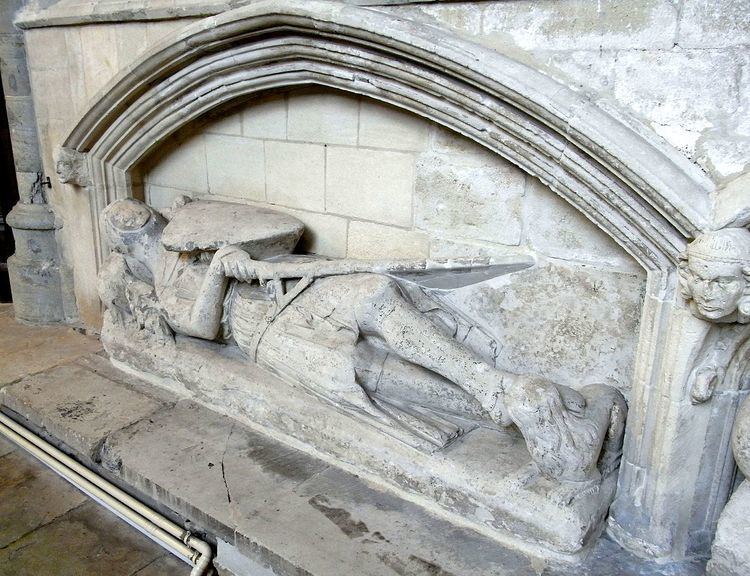 | ||
Sir Henry de Raleigh (died 1301) was a knight from Devonshire, England, whose effigy in the form of a cross-legged crusader knight survives in Exeter Cathedral.
Contents
Origins
The place of his origin is unclear from surviving records, but he was probably a member of the prominent de Raleigh family seated at the manor of Raleigh in the parish of Pilton, near Barnstaple in North Devon. In the 16th century the arms of Checquy a chief vair were recorded by the antiquarian John Leland as painted on the shield of his effigy in Exeter Cathedral, of which arms no trace remains in 2016. These arms were later adopted by the prominent Chichester family, the heirs of de Raleigh of Raleigh, Pilton, who were seated at Raleigh, Pilton, for many generations. The Devon historian Sir William Pole (d.1635) wrote as follows concerning Exeter Cathedral:
The Bohun knight was possibly connected with Humphrey de Bohun, 3rd Earl of Hereford, 2nd Earl of Essex (c.1249-c.1298), who is however known to have been buried at Saffron Walden Priory in Essex. His son and heir was Humphrey de Bohun, 4th Earl of Hereford (1276-1322) one of whose daughters was Margaret de Bohun (1311-1391), the wife of Hugh Courtenay, 2nd Earl of Devon (d.1377), of Tiverton Castle, whose effigies lie a few feet away from the Bohun/Raleigh knightly effigies, in the south transept of Exeter Cathedral, but were originally situated in a chantry chapel on the south side of the nave.
Pole's descendant Sir John de la Pole, 6th Baronet (1757-1799), who published his ancestor's manuscripts in 1791 as "Collections Towards a Description of the County of Devon", added a footnote to Pole's observation as follows: "These are now the arms of Chichester, whose ancestor married the heiress of Ralegh, whereby that estate came to Chichester, who probably took the arms of Ralegh".
Death & burial
He is known to have died whilst living at the Dominican Friary in Exeter, whence his body was forcibly removed by two Cathedral canons, including Walter de Stapledon (d.1326), later Bishop of Exeter, and given burial in the Cathedral.
Monument in Exeter Cathedral
It is not certain which of the two contemporary effigies of cross-legged knights situated next to each other under separate niches set into the north wall of the south ambulatory of Exeter Cathedral represents Raleigh. Orme (2008) is one of the few commentators who has attempted to decide the matter, and he selected the westernmost (left-hand) effigy, under the arched canopy, as representing Raleigh, thus assigning de Bohun to the easternmost effigy, under the ogee-shaped canopy. The cross-legged and "lively" form of these effigies, of which several exist elsewhere in England, most notably in the Temple Church in the City of London, are generally supposed to represent crusaders, possibly members of the Knights Templar order.
